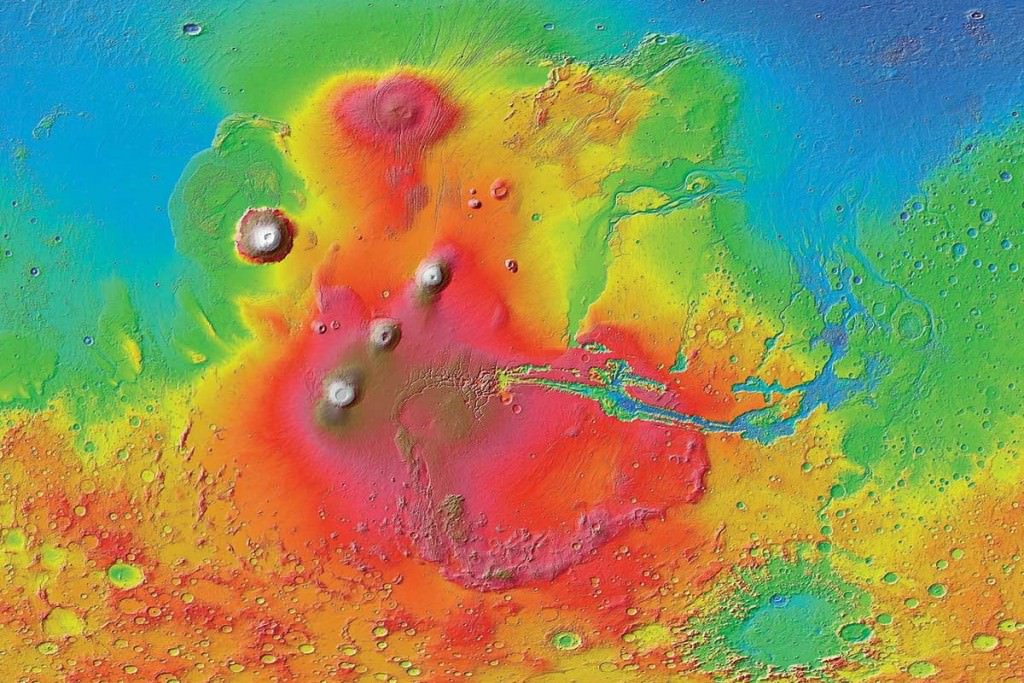Human visitors to Mars need somewhere to shelter from the radiation, temperature changes and dust storms that plague the planet. If the planet is anything like Earth or the Moon, it may have large underground lava tubes that could house shelters. Collapsed sections of lava tubes, called roofs, may provide access to these underground shelters.
Does this hole on Mars lead to a larger underground cave?
This image was captured by the High Resolution Imaging Science Experiment (HiRISE) camera on NASA’s Mars Reconnaissance Orbiter (MRO).
The crater is only a few meters wide and is in the Arsia Mons region of Mars. Arsia Mons is one of three dormant volcanoes in the Tharsis Montes group of three volcanoes.

The Tharsis region of the Tharsis Bulge is a large volcanic field that is thousands of kilometers wide. It is elevated relative to the rest of Mars and averages about 10 km (33,000 ft) above the planet’s average elevation. The region was volcanically active in the past, of course, and features like the crater are a direct result of ancient volcanic activity.
Some sinkholes in the Arsia Mons region may be collapsed windows or openings in underground lava tubes.
However, there are many uncertainties. The image of one of them shows an illuminated sidewall, which may indicate that it is simply a cylindrical pit.

The hole in the image shown can only be a pit or shaft and not an entrance to a cave or lava tube. They are found in Hawaiian volcanoes, where they are called pit craters. They are not associated with long caves or lava tubes. They are the result of a collapse that occurred much deeper underground.

In Hawaii, sinkhole craters range from 6 to 186 meters (20 to 610 feet) deep and from 8 to 1,140 meters (26 to 3,740 feet) wide. The Arsia Mons crater in the main image is only about 178 meters (584 feet) deep.
We have a much better understanding of craters and lava tubes on the Moon than on Mars. We know that some of them are thermally stable at around 17 C (63 F.) We also have better images of them, with intriguing views of stone-covered floors.

Much thought is being given to how to explore these lunar caves and lava tubes, including conceptual designs for robots that could explore them. Perhaps on the Moon, astronauts could shelter in inflatable habitats inside these tubes, where they are protected from temperature fluctuations, radiation and micrometeorites.
But Mars is another question. There is no reason that lava tubes should not exist on Mars. In fact, Mars’ gravity is much weaker than Earth’s, and this should allow for much larger tubes.
Images of Mars show rilles, which are collapsed tubes. It seems likely that not all of these tubes collapsed to form flows.
One crater in the Martian volcano, Pavis Mons, is particularly intriguing. There is some kind of void under the pit, but the nature of the pit is difficult to determine. Is it a lava tube? If so, it dwarfs most tubes on Earth.
frameborder=”0″ allow=”accelerometer; Play automatically; clipboard-write; encrypted media; gyroscope; picture-in-picture; web-share” referrerpolicy=”strict-origin-when-cross-origin” allowfullscreen>
Martian lava tubes are still a mystery. Scientists have found a lot of morphological evidence to suggest that they are numerous.
But in science, you cannot assume that they are there, even though it seems likely that they are. There is no obvious reason why they wouldn’t be. Could they one day provide housing for astronauts? Maybe.
We need a robotic mission to explore them first.
This article was originally published by Universe Today. Read the original article.
